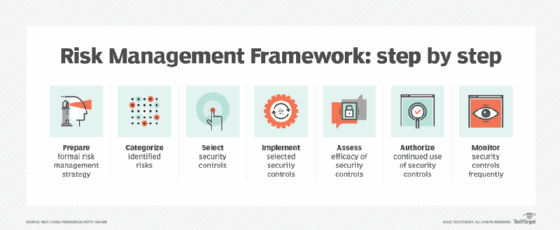What is risk monitoring? Definition and best practices
In today's complex environment, risk monitoring provides systematic identification and analysis of threats, enabling organizations to address issues proactively.
Risk monitoring is the ongoing process of identifying, understanding, assessing, monitoring, managing, and mitigating risks that could adversely affect an organization's operations, value, assets and reputation.
The goal of risk monitoring is to ensure the risk environment is recognized, new risks are identified and included in risk planning, identified risks remain within acceptable limits and risk events are dealt with effectively. Risk monitoring involves several key activities, including the following:
- Identifying threats from various internal and external sources.
- Monitoring threats that are identified and understood.
- Creating risk mitigation strategies (strategic risk management).
- Updating or adapting risk management as the threat landscape evolves.
For example, hacking and malicious network-based attacks present varied risks to the business. Cybersecurity is the principal risk management mechanism intended to identify, monitor and mitigate those risks to the business and its data.
Why is risk monitoring important?
Risk monitoring enables business leaders to recognize and understand potential threats. Threats can be diverse and far-reaching, including the following:
- Changes in customer buying habits.
- Competitor behaviors and the shifting demands of a competitive market landscape.
- Compliance violations due to factors such as employee errors, malicious attacks or unanticipated regulatory changes.
- Litigation from business activities or failures of the organization's products or services.
- Disruptions in the supply chain or internal operations, such as a manufacturing disruption.
- Financial issues such as credit or cash flow problems, which might impair the business.
Strategic risk analysis initiatives help identify risks and assess their probabilities. Once understood, identified risks can be mitigated through proper planning and strategic preparation. Risk monitoring provides ongoing evaluation of risks and registers changes in their probability, so organizations can proactively shift resources to maintain a suitable risk mitigation posture or adjust strategies to minimize the impacts of potential risks.
Risk monitoring offers several potential benefits to the business, including the following:
- Better decision-making. The data collected from risk monitoring can help optimize resource allocation, improve ongoing strategic planning, and improve risk mitigation postures.
- Early detection. Risk monitoring can highlight changing threat landscapes, warning business leaders when new threats emerge, or alerting to changes in risk probabilities that warrant timely action to prevent risks from evolving into crises.
- Regulatory adherence. Risk monitoring and management are increasingly important elements of an organization's regulatory compliance efforts, preventing litigation and penalties.
- Optimized resources. Business resources are finite. Risk monitoring enables a business to track the highest probabilities of the most serious threats, helping business leaders to direct finite resources most effectively to mitigate risks.
- Crisis prevention. Proper risk monitoring can prevent risk events that might otherwise disrupt the business. This reduces the potential costs and penalties of downtime, improves ongoing operations, and enhances stakeholders' confidence in the business's awareness of risks and suitable responses.
- Cost mitigation. Risk events can be costly in terms of damage to equipment, loss of data, consequential regulatory penalties and litigation, and lost revenue. Proper risk management reduces the likelihood of risks becoming events and reduces the effect of risk events when they occur.
Ultimately, risk monitoring prevents an organization from being blindsided by risk events, helping to ensure normal operation, meet financial goals (or at least minimize financial losses), optimize resources, and maintain trust with regulators and stakeholders.
Different ways to monitor business risks
Dealing with business risks requires four fundamental elements:
-
- Recognize that a risk exists.
- Understand the likelihood and potential severity of the risk (called a risk profile).
- Monitor the risk profile for any changes.
- Adjust resources and planning to meet the changing risk landscape.
Changes to each risk profile can intensify or mitigate a given risk. Business risks require regular monitoring to identify changes to risk profiles, giving the business opportunities to allocate resources, update plans and change strategies to ensure a proper response. This gives businesses a strategic means of handling risks. In simpler terms, the risk monitoring process enables organizations to stay ahead of threats and mitigate risks cost-effectively.
Risk monitoring can be accomplished through a variety of manual and software-driven methods, including the following:
- Risk assessments. An assessment process involves manual input and discussion from varied stakeholders to identify risks and form current evaluations of their probability and impact. These traditional assessments require extensive collaboration and can be performed over widely varying timeframes, including months to years, depending on the nature and needs of the business. New events, such as new regulatory legislation, can trigger immediate risk assessment updates.
- Risk audits. Audits assess the effectiveness of risk management or mitigation and often involve manual duplication of key risk indicators (KRIs). For example, if a risk management process or controls are implemented, a risk audit can review the effectiveness to verify whether management is working as intended and risks are mitigated. Audits can involve careful collaboration across multiple departments or management teams.
- Key risk indicators. KRIs represent a set of established metrics used to objectively quantify potential risks. KRIs can be widely varied to meet the needs of the business, such as the number of incidents or the time to resolve incidents. KRIs are reactive and typically only provide a retrospective of risks, but the trends provided can offer early warnings of potential changes to a risk profile. For example, if a mitigation is implemented to reduce a given KPI, and the KPI remains unchanged, the mitigation may be deemed ineffective.
- Key risk factors. KRFs include a set of metrics that can be used to objectively represent possible risk factors. For example, KRFs can include the cost of materials or the likelihood of difficult new regulatory legislation being ratified into law. Where KPIs are backward-looking, KRFs are intended to be forward-looking, and increases in critical KRFs can form the basis for alerts and strategic updates. For example, if pending legislation threatens to raise material costs or restrict material availability, those factors can all represent forward-looking risks that can be monitored and factored into risk management practices.
- Risk management software. Modern businesses typically use some form of risk management software to help automate risk identification, perform risk assessments, track identified risks, gather and report KPIs, outline mitigation efforts and monitor the effectiveness of risk management initiatives. Some risk management software tools may cater to specific industries or business types, while others focus on specific types of risks, such as financial, technological or regulatory compliance risks. Other tools can provide specialized features such as real time monitoring and alerting, enabling the business to respond to certain immediate risks or changes to risk profiles.
Regulations that involve risk monitoring
Most modern businesses are subject to regulations that require some form of risk monitoring and response planning. These regulations are intended to ensure that organizations operating within a regulatory jurisdiction can adequately identify, assess, manage, and mitigate critical risks. Such risks are often related to environmental management, financial management and data protection.
Environmental regulations involving risk monitoring
Organizations that operate with hazardous chemicals, waste materials, dangerous byproducts -- such as smoke discharge -- or other substances may be governed by several environmental regulations, including the following:
- Environmental Protection Agency regulations. The U.S. EPA is responsible for various regulations to protect the environment, including air, land and water quality. Businesses operating with hazardous substances, waste management and environmental factors are bound by EPA regulations. Examples of EPA regulations include the management and mitigation of asbestos and the use of antimicrobial pesticides.
- EPA's Risk Management Program Rule. The RMP requires businesses using hazardous materials or substances to develop and implement detailed plans that outline risk mitigation, accident prevention and emergency response actions when an incident occurs. RMP typically applies to businesses operating in the U.S. and subject to EPA regulations.
- Clean Water Act and Clean Air Act. These EPA-based regulations require the monitoring and reporting of water and air pollution by any business producing, discarding or discharging potentially hazardous substances. This is common for manufacturers and utilities, such as power plants and sewerage treatment facilities, but can also apply to everyday manufacturers working with various chemical agents.
Financial regulations that require risk monitoring
Financial regulations are intended to ensure that businesses operate in a fair and transparent manner and that regular financial reporting contains well-defined, well-understood and well-supported information for shareholders and stakeholders. Common financial regulations include the following:
- Sarbanes-Oxley Act. SOX outlines various internal auditing and data protection requirements for U.S. businesses intended to safeguard investors and stakeholders against business accounting fraud, such as inaccurate or misleading financial reporting.
- Dodd-Frank Act. The Dodd-Frank Act imposes provisions for financial regulation and consumer protection to safeguard against risks present in the financial system. Dodd-Frank typically operates in tandem with SOX and other regulations to extend regulatory control over financial systems to ensure stability, uniformity and accountability.
- Gramm-Leach-Bliley Act. GLBA is a mixed regulation intended to protect customer data, require financial institutions to implement security controls, and establish comprehensive data privacy. GLBA also requires detailed risk assessments and security policies.
- Basel III. Basel III provides an internationally recognized framework for banking regulation. The regulation focuses on well-defined standards for business capitalization and comprehensive risk management practices.
Several additional regulations, such as the Financial Services Cybersecurity Regulation (23 NYCRR Part 500), SEC securities regulations, and consumer protection regulations from the CFPB, are intended to mandate risk monitoring and compliance.
Data protection regulations that require risk monitoring
Data protection is the most dynamic and rapidly evolving regulatory area that includes risk monitoring and reporting. Modern businesses rely on extensive data collection and processing, with vast amounts of data collected, categorized, and processed automatically. Such practices can place enormous volumes of personal data at risk in the event of a breach. Data protection regulations are intended to mitigate the impacts of such events, and include examples such as:
- General Data Protection Regulation. The GDPR is the principal data protection regulation for businesses operating in the European Union (EU). GDPR sets comprehensive requirements outlining how personally identifiable information (PII) is collected, used, and safeguarded for EU consumers.
- California Consumer Privacy Act (CCPA) and California Privacy Rights Act (CPRA). California residents are protected by two state-level regulations (CCPA and CPRA) designed to ensure the protection and management of PII, including the rights to access, update, delete and opt out of certain data uses.
- Health Insurance Portability and Accountability Act. HIPAA regulations include provisions for data security, which require providers and business associates to perform comprehensive risk assessments to ensure compliance with HIPAA protections. Such assessments help identify possible vulnerabilities in data protection for protected health information and PII.
- Payment Card Industry Data Security Standard. PCI DSS is a set of technical and operational requirements designed to support security safeguards that protect cardholder data. Major credit cards such as Visa, MasterCard, American Express and Discover mandate that any organization that handles or stores credit card information use PCI DSS.
Best practices for effective risk monitoring
Risk monitoring is a dynamic activity – once implemented, the process of identifying, assessing and mitigating risks requires continuous attention and effort across the organization. Such continuous attention is critical to ensure that resource allocation and mitigation strategies remain timely and effective. Some best practices for ensuring effective risk monitoring include the following:
- Build a comprehensive risk monitoring framework. This means establishing a comprehensive series of steps needed to identify, assess, mitigate and monitor risks. There are several common methodologies that can be adopted and integrated into a risk management framework, such as the 5Rs (recognize, rank, respond, report, review) or the 4 Cs (culture, competence, control, communication). Other methodologies might include ISO 27005 for information security risk management or NIST SP 800-53 for system security. The selected risk management framework should be consistent with the organization's business goals, industry and regulatory obligations, and risk tolerance.
- Apply responsibility and accountability. Risk management is a team sport that requires attention and input from knowledgeable individuals or teams from across the business. Each member or team should be responsible for monitoring specific risks. For example, a financial team might be responsible for monitoring financial risks, while an IT team might be responsible for monitoring data security risks. Each responsible entity should have the authority to address, escalate, and remediate risks when issues arise or risk profiles change.
- Build risk monitoring into business culture. Risk monitoring cannot be insular and is more effective when integrated into the corporate culture. Employees must be encouraged and empowered to identify and report risks. Monitoring should be an integral part of daily workflows and processes. For example, an IT team might regularly review security dashboards and logs to identify potential malicious activity. Regardless of the individual activities, risk monitoring must be treated as a continuous process for periodic reviews of mitigation strategies and new risk assessments.
- Implement risk monitoring education and training. Part of risk monitoring and business culture is the need for risk monitoring education. Training is used to raise awareness of business risks and risk monitoring efforts across the business, and additional training can prepare employees to assist in efforts such as risk identification, assessment and mitigation.
- Use software to streamline and automate. Numerous risk monitoring tools can support risk identification, tracking, alerting, and reporting. Risk management software can automate data collection (such as KRIs and KRFs), compare data against established risk thresholds and generate reporting and alerting as metrics dictate. Real-time monitoring software is also available with dashboards and alerting to help organizations respond to immediate problems.
- Select appropriate risk monitoring metrics. Metrics, such as KRIs, are vital to risk monitoring, but more metrics are not always better. Metrics only matter when they are relevant to the business and its risk mitigation strategies. Select a cross-section of metrics that best align with risk concerns or regulatory compliance obligations.
- Review and update risk monitoring frequently. Risk monitoring will change as business needs and risk profiles change. Risk monitoring practices and workflows should be reviewed and updated regularly as part of any regular strategic risk management effort.

Risk monitoring tools and software
There are many GRC (governance, risk management and compliance) tools available to fit almost any business size, need, industry vertical, and budget. Some tools are broad and general, while others focus on specific portions of the risk management process, such as risk assessment. A web search of popular risk monitoring tools illustrates a variety of tools, including the following:
- Airtable.
- Appian.
- Archer.
- AssessNET.
- BitSight.
- Black Kite.
- Corporater.
- CyberGRC.
- Drata.
- EcoOnline.
- HyperProof.
- Jira.
- Kissflow.
- LogicGate.
- LogicManager.
- MetricStream.
- Mitratech.
- Nintex.
- OneTrust.
- RAMs App.
- Resolver.
- Riskalyze.
- Riskonnect.
- SecurityScorecard.
- StandardFusion.
- SureCloud Platform.
- UpGuard.
- Vanta.
Given the number and diversity of risk software available, organizations must exercise due diligence in tool selection. They should narrow potential candidates and then perform detailed proof-of-concept projects with several promising alternatives before making the decision to adopt a specific tool. Factors such as future business needs, vendor support, integrations, product roadmap and costs should also be considered.
Stephen J. Bigelow, senior technology editor at TechTarget, has more than 30 years of technical writing experience in the PC and technology industry.







